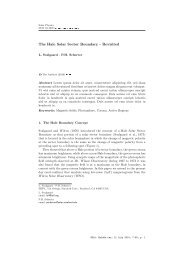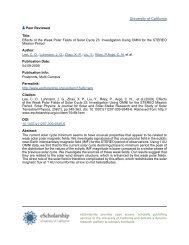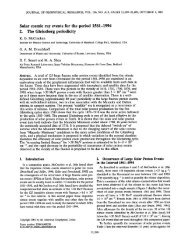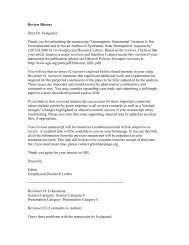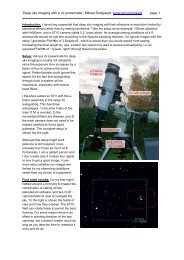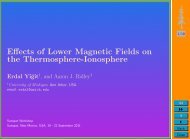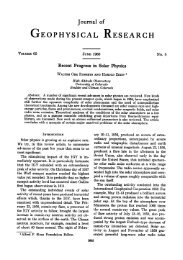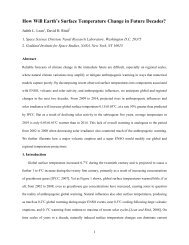The sum of two COSine waves is equal to [twice] the product of two ...
The sum of two COSine waves is equal to [twice] the product of two ...
The sum of two COSine waves is equal to [twice] the product of two ...
Create successful ePaper yourself
Turn your PDF publications into a flip-book with our unique Google optimized e-Paper software.
Toy Solar Cycles<br />
<strong>The</strong> <strong>sum</strong> <strong>of</strong> <strong>two</strong> cosine <strong>waves</strong> <strong>is</strong> <strong>equal</strong> <strong>to</strong> [<strong>twice</strong>] <strong>the</strong> <strong>product</strong> <strong>of</strong> <strong>two</strong> o<strong>the</strong>r cosine <strong>waves</strong>:<br />
cos α + cos β = 2 cos [(α + β)/2] cos [(α - β)/2]<br />
Th<strong>is</strong> means that it <strong>is</strong> impossible <strong>to</strong> d<strong>is</strong>tingu<strong>is</strong>h between <strong>two</strong> times series that are <strong>sum</strong>s <strong>of</strong><br />
<strong>waves</strong> or <strong>product</strong>s <strong>of</strong> [related] <strong>waves</strong>, and hence impossible <strong>to</strong> decide what <strong>the</strong> underlying<br />
processes are: <strong>sum</strong>s <strong>of</strong> <strong>waves</strong> or <strong>product</strong>s <strong>of</strong> <strong>waves</strong>. We’ll illustrate th<strong>is</strong> with a <strong>to</strong>y<br />
example – which looks, however, quite similar <strong>to</strong> <strong>the</strong> sunspot record.<br />
Take Vukcevic’s numerological sunspot formula. It <strong>is</strong> a poor fit <strong>to</strong> <strong>the</strong> actual record, but<br />
will do as a <strong>to</strong>y example:<br />
SSN Vuk = abs[cos(2π/4+2π/A (t-t o ))+cos(2π/B (t-t o ))]<br />
Where <strong>the</strong> <strong>two</strong> constants A = 2 * Jupiter’s orbital period = 23.7 years, and B = time<br />
between conjunctions <strong>of</strong> Jupiter with Saturn = 19.9 years, and t o <strong>is</strong> a suitable epoch.<br />
We can construct ano<strong>the</strong>r <strong>to</strong>y series that has real connection <strong>to</strong> <strong>the</strong> solar cycle and uses<br />
<strong>the</strong> <strong>product</strong> <strong>of</strong> <strong>two</strong> SIN <strong>waves</strong> [makes no difference if SIN or COS]:<br />
SSN Real = abs [sin(2π/C (t-t o )/2) sin(2π/D (t-t o )/2)]<br />
Where <strong>the</strong> <strong>two</strong> constants C = 10.8 years and D = 120 years describe <strong>the</strong> length <strong>of</strong> an<br />
average sunspot cycle and <strong>of</strong> <strong>the</strong> ‘long’ cycle. <strong>The</strong>se <strong>two</strong> values were chosen <strong>to</strong> match <strong>the</strong><br />
Vukcevic series. In both formulae <strong>the</strong> absolute value <strong>is</strong> used because <strong>the</strong> sunspot number<br />
<strong>is</strong> always positive. <strong>The</strong> FFTs <strong>of</strong> both series are identical <strong>to</strong> many decimal places [and<br />
with a very small amount <strong>of</strong> random no<strong>is</strong>e become truly ind<strong>is</strong>tingu<strong>is</strong>hable]. We have<br />
calculated <strong>the</strong>m for yearly values for <strong>the</strong> interval 1600-2150 AD:
<strong>The</strong> <strong>two</strong> curves have been multiplied by arbitrary fac<strong>to</strong>rs <strong>to</strong> avoid falling on <strong>to</strong>p <strong>of</strong> each<br />
o<strong>the</strong>r [<strong>the</strong>y are virtually identical].<br />
<strong>The</strong> ~120 year ‘long cycle’ peak <strong>is</strong> prominent, as well as <strong>the</strong> ‘solar cycle’ line at 10.78<br />
years, which <strong>is</strong> split in<strong>to</strong> <strong>two</strong> side peaks at 9.94 and 11.91 years. Several [uninteresting]<br />
harmonics are also present.<br />
From <strong>the</strong> power spectrum we cannot d<strong>is</strong>tingu<strong>is</strong>h between <strong>the</strong> <strong>two</strong> cases. Ei<strong>the</strong>r we have<br />
<strong>two</strong> <strong>waves</strong> [<strong>of</strong> 19.9 and 23.7 years] added <strong>to</strong>ge<strong>the</strong>r or we have one principal cycle [<strong>of</strong><br />
10.8 years duration] amplitude-modulated by a 120 year wave. In <strong>the</strong> case <strong>of</strong> <strong>the</strong> Sun,<br />
which <strong>is</strong> it From <strong>the</strong> time series analys<strong>is</strong> alone we cannot tell. You can, <strong>of</strong> course,<br />
choose one or <strong>the</strong> o<strong>the</strong>r, but <strong>the</strong>n it <strong>is</strong> just your [arbitrary] choice. It comes down <strong>to</strong><br />
finding a model for <strong>the</strong> processes.<br />
In signal processing an <strong>of</strong>ten used model <strong>is</strong> that <strong>of</strong> modal excitation, where eigenmodes<br />
are excited by some external force or even by no<strong>is</strong>e in <strong>the</strong> system. <strong>The</strong> eigenmodes are<br />
usually superposed on each o<strong>the</strong>r and excitation <strong>of</strong> one mode does not influence a<br />
different mode. For our Vukcevic <strong>to</strong>y-example th<strong>is</strong> model would have <strong>two</strong> modes with<br />
periods 19.9 and 23.7 years, that are strictly cyclic [a real system may not observe strict<br />
cycles].<br />
But we could also generate <strong>the</strong> same spectrum with a single cycle with period 10.8 years,<br />
amplitude modulated by a longer cycle with period 120 years. We could choose th<strong>is</strong><br />
model instead which would correspond <strong>to</strong> very different physics. All our observations <strong>of</strong><br />
<strong>the</strong> Sun favor th<strong>is</strong> amplitude-modulated single cycle model. A solar cycle can semiempirically<br />
be described as follows: Magnetic flux <strong>is</strong> by a meridional circulation<br />
transported <strong>to</strong> high latitudes where it advects or diffuses <strong>to</strong> <strong>the</strong> interior <strong>of</strong> <strong>the</strong> sun [<strong>the</strong><br />
exact depth <strong>is</strong> debated, but <strong>is</strong> not important here]. During <strong>the</strong> return flow at depth <strong>to</strong>wards<br />
lower latitudes, <strong>the</strong> flux <strong>is</strong> sheared, wound up, and amplified by differential rotation. <strong>The</strong><br />
amplified magnetic field exerts a pressure <strong>of</strong> its own so pressure equilibrium can be<br />
maintained with a gas parcel containing less mass, and thus lighter than its surroundings.<br />
<strong>The</strong> field <strong>is</strong> thus buoyant and tends <strong>to</strong> r<strong>is</strong>e <strong>to</strong>wards <strong>the</strong> surface. <strong>The</strong> r<strong>is</strong>ing field <strong>is</strong> frayed<br />
and arrives at <strong>the</strong> surface as many small field elements. <strong>The</strong>se quickly assemble or<br />
concentrate in<strong>to</strong> larger clumps <strong>of</strong> magnetic flux with like polarity seeking out like<br />
polarity [because such a configuration has lower energy than one where opposite<br />
polarities are pulled apart]. Sunspots result if th<strong>is</strong> process <strong>is</strong> efficient enough, but soon<br />
decay by being nipped apart by granular movements. <strong>The</strong> decaying field <strong>is</strong> transported <strong>to</strong><br />
<strong>the</strong> poles by meridional circulation. Because <strong>the</strong> wound-up field <strong>is</strong> not exactly East-West,<br />
but inclined a few degrees, one polarity [<strong>the</strong> one trailing rotation] has a better chance <strong>of</strong><br />
making it <strong>to</strong> <strong>the</strong> pole than <strong>the</strong> o<strong>the</strong>r. Th<strong>is</strong> reverses <strong>the</strong> field at <strong>the</strong> poles, and <strong>the</strong> process<br />
repeats with <strong>the</strong> next cycle now being <strong>of</strong> <strong>the</strong> opposite polarities. <strong>The</strong>se processes are<br />
observed in detail and proceed with regularity, forming a sequence <strong>of</strong> single cycles with<br />
reversing polarities. <strong>The</strong> size <strong>of</strong> a given cycle <strong>is</strong> determined partly by how big <strong>the</strong><br />
previous cycle was [giving pers<strong>is</strong>tence] and partly by pure chance as less than 1% <strong>of</strong> <strong>the</strong><br />
magnetic field makes it <strong>to</strong> <strong>the</strong> poles, thus easily perturbed by random events and<br />
movements [giving variation]. In addition, <strong>the</strong>re seems <strong>to</strong> be longer–term variations <strong>of</strong>
<strong>the</strong> speed <strong>of</strong> <strong>the</strong> circulations [<strong>the</strong> causes <strong>of</strong> those variations are still debated] that<br />
influences <strong>the</strong> efficiency <strong>of</strong> ei<strong>the</strong>r generation or assembly <strong>of</strong> <strong>the</strong> field, thus leading <strong>to</strong><br />
cycles <strong>of</strong> different sizes.<br />
Solar activity enhances <strong>the</strong> em<strong>is</strong>sion <strong>of</strong> <strong>the</strong> ‘Green Line’ corona as shown here [Altrock,<br />
2011]. Note <strong>the</strong> ‘extended solar cycle’ [red arrow] lasting ~17 years. Each cycle begins at<br />
high latitudes and over <strong>the</strong> next ~17 years works its way down <strong>to</strong> <strong>the</strong> equa<strong>to</strong>r. At all times<br />
<strong>the</strong> activity bands <strong>of</strong> <strong>two</strong> adjacent cycles are present:<br />
It <strong>is</strong> on <strong>the</strong> bas<strong>is</strong> <strong>of</strong> <strong>the</strong> observed behavior that we prefer a model with amplitudemodulated<br />
repeating and self-generating single-cycle [but overlapping] instances, ra<strong>the</strong>r<br />
than random excitation <strong>of</strong> modes that are not supported by <strong>the</strong> constitution and structure<br />
<strong>of</strong> <strong>the</strong> actual sun and lacking forces <strong>to</strong> provide <strong>the</strong> excitation.<br />
Turning now <strong>to</strong> <strong>the</strong> real solar cycle we calculate <strong>the</strong> FFT <strong>of</strong> monthly averages 1749-2011.<br />
<strong>The</strong> long ‘cycle’ <strong>is</strong> hard <strong>to</strong> resolve due <strong>to</strong> <strong>the</strong> limited length <strong>of</strong> <strong>the</strong> data, but <strong>is</strong> clearly<br />
present along with its harmonics. <strong>The</strong> long cycle <strong>is</strong> likely not a real cycle but does<br />
expresses pers<strong>is</strong>tence in <strong>the</strong> patterns <strong>of</strong> solar cycle intensity: small cycles tend <strong>to</strong> occur in<br />
groups as does large cycles.
25<br />
22.5<br />
20<br />
17.5<br />
15<br />
12.5<br />
10<br />
7.5<br />
5<br />
2.5<br />
0<br />
Monthly Sunspot Numbers, 1749-2011<br />
1 2 3 4 5 67 10 20 30 50 70100 200<br />
Period, Years<br />
<strong>The</strong> primary cycle peak again has side peaks due <strong>the</strong> long cycle, at 10.04, 11.01, and<br />
11.77 years:<br />
A powerful way <strong>of</strong> asserting <strong>the</strong> repeatability [stationarity] <strong>of</strong> cycles <strong>is</strong> <strong>to</strong> do <strong>the</strong> analys<strong>is</strong><br />
on subsets <strong>of</strong> <strong>the</strong> data. We split <strong>the</strong> 262 year record in<strong>to</strong> <strong>two</strong> 131-year parts and calculate<br />
<strong>the</strong> FFT separately for each:<br />
<strong>The</strong> long cycle <strong>is</strong> now [obviously] less d<strong>is</strong>tinct. <strong>The</strong>re are still side peaks <strong>to</strong> <strong>the</strong> 11-year<br />
primary solar cycle, but much less stable. We expect th<strong>is</strong> because <strong>the</strong> solar ‘cycle’ <strong>is</strong> not<br />
really a cycle in any strict sense as each cycle develops contingent on many random<br />
fac<strong>to</strong>rs, e.g. availability <strong>of</strong> ex<strong>is</strong>ting flux and changes <strong>to</strong> meridional circulation.


![The sum of two COSine waves is equal to [twice] the product of two ...](https://img.yumpu.com/32653111/1/500x640/the-sum-of-two-cosine-waves-is-equal-to-twice-the-product-of-two-.jpg)

![When the Heliospheric Current Sheet [Figure 1] - Leif and Vera ...](https://img.yumpu.com/51383897/1/190x245/when-the-heliospheric-current-sheet-figure-1-leif-and-vera-.jpg?quality=85)

